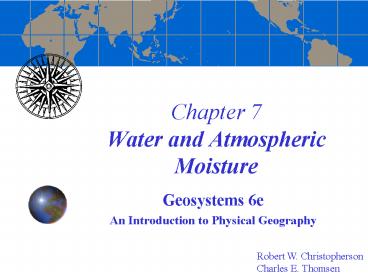Chapter 7 Water and Atmospheric Moisture - PowerPoint PPT Presentation
1 / 35
Title:
Chapter 7 Water and Atmospheric Moisture
Description:
Adiabatic Processes. Adiabatic processes. Begins with a parcel of air ... Moist adiabatic rate (MAR) Also called the Wet Adiabatic Lapse Rate (WALR) 6 C / 1000 m ... – PowerPoint PPT presentation
Number of Views:66
Avg rating:3.0/5.0
Title: Chapter 7 Water and Atmospheric Moisture
1
Chapter 7Water and Atmospheric Moisture
- Geosystems 6e
- An Introduction to Physical Geography
Robert W. Christopherson Charles E. Thomsen
2
Water and Atmospheric Moisture
- TOPICS
- Adiabatic Processes
- Atmospheric Stability
- Clouds
- Fog
3
Adiabatic Processes
- Adiabatic processes
- Begins with a parcel of air
- Bouyancy caused initially by differences in
(near) surface temperature - Less dense, warmer air rises, more dense, colder
air sinks, after which - Ascending or descending air will undergo changes
in temperature with no exchange of heat. This is
an adiabatic process.
4
Buoyancy
Figure 7.15
5
Adiabatic Processes
- Adiabatic processes
- Normal lapse rate the average decrease in
temperature with increasing altitude - Environmental lapse rate the actual lapse rate
at a particular place and time - Ascending or descending air will undergo changes
in temperature with no exchange of heat. This is
an adiabatic process. - Heat WAS exchanged diabatic process.
6
Adiabatic Processes
Figure 7.17
7
Adiabatic Processes
- Dry adiabatic rate (DAR)
- Also called the Dry Adiabatic Lapse Rate (DALR)
- 10 C/ 1000 m
- 5.5 F/ 1000 ft
- Lifting Condensation Level (LCL) is reached,
then - Moist adiabatic rate (MAR)
- Also called the Wet Adiabatic Lapse Rate (WALR)
- 6 C/ 1000 m
- 3.3 F/ 1000 ft
8
(No Transcript)
9
(No Transcript)
10
AtmosphericStability
Figure 7.20
11
Atmospheric Stability
- Stable and unstable atmospheric conditions
- Involves a parcel of air and its surrounding
environment in the atmosphere - Stable atmosphere
- A parcel of air is discouraged from rising
- Kind of weather normally associated?
- Unstable atmosphere
- A parcel of air is encouraged to rise
- Kind of weather normally associated?
12
Examples of Stability
Unstable AtmosphereParcel of air is encouraged
to rise
Figure 7.20
13
Examples of Stability
Stable AtmosphereParcel of air is discouraged
from rising
Figure 7.20
14
Atmospheric Stability
- To determine atmospheric stability
- Compare the ELR with the DAR (or DALR) and MAR
(or WALR) - If ELR lt MAR lt DAR STABLE
- If ELR gt DAR gt MAR UNSTABLE
- If MAR lt ELR lt DAR CONDITIONALLY UNSTABLE
15
Atmospheric Stability
- For example
- We measure and find the ELR to be 12 Cº/ 1000 m
- We know the DAR is 10 Cº/ 1000 m.
- We know the MAR is 6 Cº/ 1000 m.
- If ELR (12) gt DAR (10) gt MAR (6) then?
- If ELR gt DAR gt MAR UNSTABLE
16
Atmospheric Stability
- If ELR is large (shallow slope), it will be to
the left of both the DAR and MAR lines - This describes unstable atmospheric conditions!
- If ELR is small (steep slope), it will be to the
right of both the DAR and MAR lines. - This describes stable atmospheric conditions!
17
Atmospheric Temperatures and Stability
Figure 7.19
18
Moisture Droplets
Figure 7.20
19
Raindrop and Snowflake Formation
Collision-coalescence process
Figure 7.22
20
Cloud Types and Identification
Figure 7.23
21
Cirrus
Figure 7.23
22
Cirrostratus
Figure 7.23
23
Cirrocumulus
Figure 7.23
24
Altocumulus
25
Altostratus
26
Stratus
Figure 7.23
27
Nimbostratus
Figure 7.23
28
Stratocumulus
Figure 7.23
29
Cumulus
Figure 7.23
30
Cumulonimbus
Figure 7.23
31
Cumulonimbus Development
Figure 7.24
32
Fog
- Fog a cloud layer at or very close to the
surface formed when surface air temperatures and
dewpt temperature are nearly identical - Advection fog warm, moist air layers moves over
a cold surface - Evaporation fog dole air moves over warmer
water body - Radiation fog loss of longwave radiation over
moist surface
33
Advection Fog
When warm, moist air moves over cooler body of
water, what happens?
Figure 7.25
34
Evaporation Fog
Cold air lies over warmer body of water, and
evaporation from water surface causes saturation
and fog. Also, sea smoke hazard.
Figure 7.26
35
Radiation Fog
Loss of longwave radiation at night over moist
surface causes saturation.
Figure 7.28































